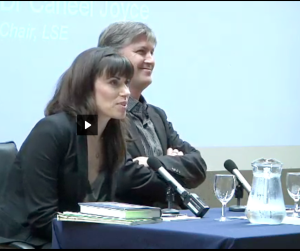
Earlier this week, Steven Johnson came to the London School of Economics to present his new book, Where Good Ideas Come From: A Natural History of Innovation. This thought leader’s fascinating talk was sponsored by my department.
(You can watch the video or download the podcast on the LSE Events website.)
At the end of his talk, I asked Johnson to explain how we as individuals can come up with more “good ideas”.
Steven described his method: He keeps one single document of all of his idea and hunches. It’s a running log of book ideas, article ideas, new theories, ideas about people to talk to, and so forth…. anything, really, that could be called an idea.
The idea of keeping one running log of ideas is related to the tradition of keeping a commonplace book, an enlightenment-era practice that Johnson himself is quite fond of – although he keeps his in a very high-tech way.
But unlike a commonplace book, this chronological list of ideas is exclusive, separated from all other thoughts and reference materials (an information-storage distinction Scott Belsky might advocate).
Then – and here’s the important bit – he reads over it every three months or so. Revisiting one’s own archive of ideas is a recurrent theme of Johnson’s. Keeping ideas in a separate log is crucial for this step, because it allows him to actually USE them eventually, when the building blocks – or he himself – are ready.
He called this process of re-reading what you’ve written at regular intervals “networking with yourself.” It’s seeing if something the present you has at your disposal is useful for the past you. It’s Johnson’s “slow hunch” concept happening inside the asynchronous neural network of the mind as it stretches across time, rather than across dense diverse networks of a city or the internet.
Re-reading has a self-affirming benefit – he often discovers years later that’s he’s done something with an idea (“Hey, that one became a book!”).
But re-reading also has a practical payoff. Personal innovation becomes more efficient and the ROI on each creative half-baked idea is multiplied. Maybe when you first have an idea, you don’t know the right people or you lack the resources needed to make things happen. Perhaps, you were missing a crucial piece of knowledge or technology. Often, you are simply not ready to implement an idea due to your own personal circumstances. In short, a “slow hunch” from years ago suddenly becomes useful because you revisited your idea log.
Check out Steven Johnson’s blog, a clever 5-minute RSA Animation illustrating Where Good Ideas Come From, and this video from his talk at the LSE.
I have started my own single-document idea log…. have you?

This is great. I often write down ideas but tend to do it all over the place. It’s fun and inspiring finding old notes here and there, but not exactly useful.
Thanks for the write-up. I started my own single-document after his talk too =) The way I think about it is the idea of networking with your ideas, or even, getting your ideas to network with each other – though I suppose you at least have to introduce them. Pretty simple really to go back and read your ideas but i bet it doesn’t happen too much.
To add to the resources I added my own notes from the talk here:
http://palojono.blogspot.com/2010/11/where-good-ideas-come-from-visual-notes.html
Thanks for posting!